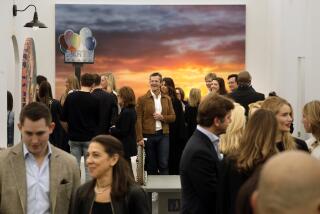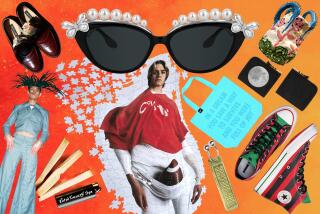Developing an artistic flair in the United Arab Emirates
DUBAI, UNITED ARAB EMIRATES — IT’S A quiet Sunday morning in this city of cacophonous ambition. Construction has yet to hit a deafening pitch, and traffic is still moving. But, as the temperature rises, all sorts of art activity bubbles up in the historic Bastakiya district, a low-lying island of traditional Arabian houses in a sea of modern high-rises.
At the hub of Bastakiya’s walled complex, XVA Gallery -- a contemporary art showcase with an eight-room guesthouse and a vegetarian cafe -- offers an international array of works, mostly by Middle Eastern artists, in a series of rooms surrounding a square courtyard.
Gallery owner Mona Hauser, an American expatriate, and Fereydoun Ave, an Iranian artist and dealer who recently joined forces with her, give drop-in visitors an impromptu tour.
Among the attractions: headless metal figures with perforated bodies by Halim Al Karim of Iraq, an installation combining a projected image of a woman’s lips with a carpet of bright red men’s hats by Hilda Hiary of Jordan, digital photographs of childhood “demons” transformed into grotesque cartoons by Malekeh Nayiny of France and Iran.
Next door at Sauce, an arty boutique favored by trendsetters with a taste for the quirky and outrageous, are Pop-flavored novelties and fluffy dresses that look like out-of-control flower gardens.
About 20 other spaces, in a maze-like arrangement, are occupied by participants in the Creek Art Fair, a showcase for emerging talent that has settled into Bastakiya for a couple of weeks.
Organized by XVA and named for Dubai Creek, the city’s central waterway, the Creek Art Fair is a spinoff of Art Dubai, the 2-year-old fair held each spring at a luxurious seaside resort and scheduled next year for March 17 to 21.
At the relatively low-key Creek event, galleries and design studios show their wares in interior spaces originally used as dwellings.
Artists’ projects, such as “Open Shutters” -- a photographic record of 12 Iraqi women’s lives, organized by British photojournalist Eugenie Dolberg -- pop up along walkways and on exterior walls.
All of which adds up to a mélange of sights and experiences that defies stereotypes. The subject matter of the art is somewhat restrained, as expected. Nudity and sex rarely appear. Yet there’s no shortage of political and social commentary that alludes to the devastation of war and the challenges of living under repressive governments.
And the fashion police are not in charge here. Stylish clerks at Sauce sport tank tops and cargo pants, as does Nadine Kanso, a Lebanese artist whose photo-and-text mural about the sad state of Beirut fills walls of a nearby courtyard. But in the same area, female art students from Zayed University who are working on a public study of color preferences wear traditional black robes -- and, occasionally, big sunglasses. Mixing duty with pleasure, the students ask passersby to play a board game intended to reveal their favorite color combinations, chat with Kanso and photograph each other with her mural.
So it goes in a part of the world where contemporary art is only beginning to be integrated into the global exhibition scene and marketplace.
Bigger is better -- way better -- in Dubai, which has exploded into an unruly mass of humongous shopping centers and glittering office towers. In a place where image makers boast of having the world’s biggest indoor ski resort and the first seven-star hotel, art is barely on the charts. But that is changing as the federation of seven United Arab Emirates adds cultural components to its tourist attractions.
Sharjah, the emirate adjoining Dubai on the north and east, has appointed itself the cultural leader of the United Arab Emirates, and it has established several museums, galleries and arts centers. But Abu Dhabi, the federal capital that borders Dubai on the south, has spectacularly ambitious plans to build an arts complex designed by leading architects that will outshine anything else in the region.
The Cultural District of Saadiyat Island, or the Island of Happiness, is expected to transform a 16.7-square-mile island into a cultural destination. Phase One of the plan includes Frank Gehry’s Guggenheim Abu Dhabi, a branch of the modern and contemporary art institution in New York; Jean Nouvel’s Louvre Abu Dhabi, described as a “classical museum” that will display part of the Paris museum’s collection; and Norman Foster’s Sheikh Zayed National Museum, a showcase for the United Arab Emirates’ heritage. All three are slated for completion in 2012-13, although construction has yet to begin.
The scheme and timetable require a certain leap of faith, but a large exhibition of models, photographs and explanatory text has been installed at the luxurious Emirates Palace Hotel in Abu Dhabi to “prepare the audience,” as Rita Aoun, art advisor for the cultural district, puts it. “Art and culture have been identified as the key to putting Abu Dhabi on the international scene, and to creating a sort of platform for the region,” she says.
An additional exhibition, “The Arts of Islam: Treasures From the Nasser D. Khalili Collection,” makes the point that visitors who return to Abu Dhabi in a few years can expect to see great art in the proposed buildings. More than 500 objects from a private collection in London compose a sweeping survey of calligraphy, textiles, ceramics, jewelry, metalworks, glassware and painting made from the 7th to the 20th centuries.
The show and an accompanying symposium “set the tone of Abu Dhabi’s cultural ambitions,” according to an official statement from Sheikh Sultan Bin Tahnoon Al Nahyan, chairman of the Abu Dhabi Authority for Culture and Heritage and the state-run Tourism Development and Investment Co.
Meanwhile, Dubai, the undisputed commercial center of the emirates, has staked out its place as the marketplace for contemporary art. Although Istanbul, Turkey, has put itself on the art world’s map with a biannual international exhibition, Dubai seems to be filling a void in the Islamic Middle East.
And Christie’s auction house has helped. The firm established an office here in 2006 and held its first sale of modern and contemporary art that spring. Sales in the “Arab and Iranian section” brought $2.2 million the first time around, rose to $4 million in February 2007 and jumped to more than $12.6 million in October.
Flowering of galleries
ABOUT 25 galleries, mostly run by foreigners, have taken root in Dubai over the last couple of decades, along with 15 shops and cafes that host art shows.
Some galleries are in hotels and other buildings sprinkled along the coast; many others have set up shop in an industrial area, Al Quoz. B21,the Third Line and Meem, for example, occupy rudimentary metal structures amid factories and warehouses on paved back streets lined with sand.
On this particular day, B21 offers paintings by Iranian artist Rokni Haerizadeh, whose satirical views of contemporary life in Iran are often inspired by Persian literature. Third Line has “Until the End of the World,” an installation of paintings, neon and tumbleweeds by British artist Shezad Dawood, said to mix the fundamentals of Islam with the avant-garde. Meem displays large paintings of historical objects at Istanbul’s Topkapi Palace Museum by Turkish artist Ismail Acar.
Another outpost, the Courtyard, houses galleries, a cafe, interior design shops and offices in an eclectic, two-story complex.
It’s the creation of Dariush Zandi, a U.S.-educated Iranian architect who first visited Dubai in 1978 and returned a few years later. He founded the Courtyard to promote art in the emirates in 1981 and set up a gallery, Total Arts, on the second floor.
The current show features figurative paintings by Bahram Hajou, a Syrian artist who lives in Germany.
Doing business in contemporary art isn’t easy here, Zandi says, but a few pioneers have survived, and many others have joined them in the last few years. Although no one understood his compulsion to establish a gallery in Dubai and few people came to see it in the early days, the response is much stronger now, he says.
“I was used to going to the Guggenheim and the Met and MoMA in New York,” Zandi says, recalling his U.S. sojourn in the 1970s. “When I came here, I had to do something. There was nothing.”
For Hauser, it took four years to get official permission and make preparations for XVA, her gallery, guesthouse and cafe.
But the notion of Dubai as an art center is catching on, she says, and the art world has taken notice of her guesthouse. “The reality is already way beyond the dream,” she says, heading into her office to take a call.
More to Read
The biggest entertainment stories
Get our big stories about Hollywood, film, television, music, arts, culture and more right in your inbox as soon as they publish.
You may occasionally receive promotional content from the Los Angeles Times.










